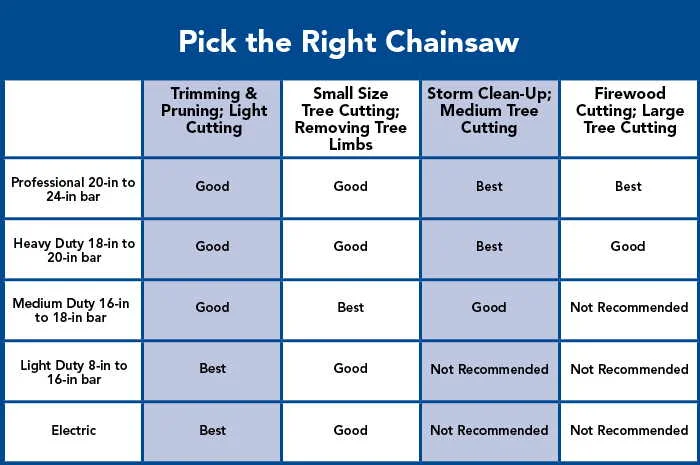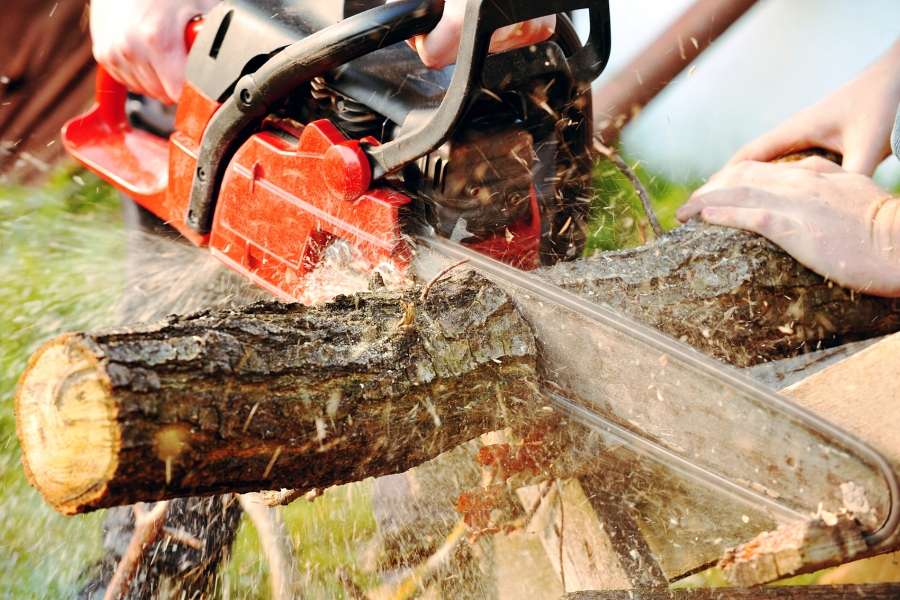Choosing the right chainsaw size can be confusing. There are many factors to consider.
When deciding what size chainsaw you need, think about the tasks you’ll tackle. Are you pruning small branches or cutting down large trees? Different jobs require different chainsaw sizes. Picking the right size will make your work easier and safer.
In this blog, we will guide you through the key considerations. We’ll help you understand how to match the chainsaw size to your needs. By the end, you’ll be ready to choose the perfect chainsaw for your tasks. Let’s dive in and find out what size chainsaw is best for you!

Credit: www.youtube.com
Introduction To Chainsaw Sizes
Choosing the right chainsaw size is crucial for your tasks. A chainsaw that’s too large or too small can be inefficient and unsafe. Understanding chainsaw sizes helps you select the best tool for your needs.
Importance Of Choosing The Right Size
The right chainsaw size impacts your safety and efficiency. A chainsaw that’s too large can be unwieldy and dangerous. A small chainsaw may not have the power for tough jobs. Selecting the correct size ensures you work effectively and safely.
Consider the type of wood you’ll cut. Softwood and hardwood require different power levels. Also, think about the length of time you’ll use the chainsaw. Longer usage needs a more comfortable and balanced tool.
Common Chainsaw Sizes
Chainsaws come in various sizes to suit different tasks. Here’s a quick guide:
| Chainsaw Size | Best For |
|---|---|
| 12-14 inches | Light pruning and small branches |
| 16-18 inches | General property maintenance |
| 20 inches | Cutting firewood and small trees |
| 24 inches and above | Large trees and heavy-duty work |
Each size serves different purposes:
- 12-14 inches: Ideal for light pruning and small branches.
- 16-18 inches: Great for general property maintenance.
- 20 inches: Suitable for cutting firewood and small trees.
- 24 inches and above: Perfect for large trees and heavy-duty work.
Consider your needs and choose the appropriate size. A well-chosen chainsaw ensures your work is safe and efficient.

Credit: onevantool.com
Factors Influencing Chainsaw Size
Choosing the right chainsaw size can be challenging. Several factors influence this decision, including the type of work and your experience level. Understanding these factors helps you make an informed choice.
Type Of Work
The type of work determines the chainsaw size you need. For light tasks like pruning or cutting small branches, a smaller chainsaw is sufficient. These tasks usually require a chainsaw with a bar length of 12 to 14 inches. Medium tasks, such as felling small trees or cutting firewood, need a chainsaw with a bar length of 16 to 20 inches. For heavy-duty tasks, such as logging or felling large trees, a larger chainsaw is necessary. These tasks often require a bar length of 22 inches or more.
Experience Level
Your experience level also affects the chainsaw size. Beginners should start with a smaller chainsaw. Smaller chainsaws are easier to handle and control. They are lighter and pose less risk of injury. Experienced users can handle larger chainsaws. These users have the skill to manage the increased power and weight. They can safely operate larger chainsaws for more demanding tasks.
Chainsaw Size For Home Use
Choosing the right chainsaw size for home use is essential. It ensures safety and efficiency. A properly sized chainsaw can make tasks easier and faster. Below, we’ll explore the ideal chainsaw sizes for common home tasks.
Trimming And Pruning
For trimming and pruning, a lightweight chainsaw is best. A chainsaw with a bar length between 8 to 12 inches works well. This size allows for easy maneuverability. It is perfect for trimming bushes and small branches. Here are some key points:
- 8 to 12-inch bar length
- Lightweight and easy to handle
- Ideal for small branches and shrubs
Small Tree Cutting
When cutting small trees, consider a slightly larger chainsaw. A bar length between 12 to 16 inches is suitable. This size provides enough power for small trees. It’s also versatile for various tasks. Here are some key points:
- 12 to 16-inch bar length
- Medium weight and more power
- Suitable for small trees and larger branches
Choosing the right chainsaw size can make your home tasks easier. Always prioritize safety and efficiency. Select a chainsaw that matches the size of your tasks.
Chainsaw Size For Professional Use
Choosing the right chainsaw size is crucial for professional use. It ensures efficiency and safety in demanding tasks. Professionals need to consider several factors, such as the type of tasks and the size of trees they deal with regularly.
Large Tree Felling
For large tree felling, a powerful chainsaw with a bar length of 20-24 inches is recommended. This size allows you to cut through thick trunks efficiently. A longer bar provides the reach needed to handle large trees.
Below is a table that illustrates the recommended chainsaw sizes for various tree diameters:
| Tree Diameter | Bar Length |
|---|---|
| Up to 20 inches | 16-20 inches |
| 20-30 inches | 20-24 inches |
| 30 inches and above | 24 inches or more |
Heavy-duty Tasks
For heavy-duty tasks, professionals require a high-performance chainsaw. Tasks such as logging, milling, and storm cleanup need a robust machine. A bar length of 18-24 inches is ideal. This range offers flexibility for various heavy tasks.
- Logging: Use an 18-24 inch bar for cutting logs.
- Milling: A 20-24 inch bar is perfect for milling lumber.
- Storm Cleanup: A 16-20 inch bar is suitable for debris removal.
Choosing the right chainsaw size ensures you can handle any professional task efficiently. Always consider the specific requirements of your job to select the best tool.
Chainsaw Bar Length Guide
Choosing the right chainsaw can be tricky. The bar length plays a crucial role. This guide will help you decide which bar length is best for your needs. We will discuss short bars, medium bars, and long bars.
Short Bars
Short bars are typically 10 to 14 inches long. They are ideal for light tasks. Use them for trimming trees, pruning, and cutting small logs. They are easy to handle. Beginners often prefer them. They are less likely to cause kickback. This makes them safer for new users. Short bars are also lighter. This means less fatigue during use.
Medium Bars
Medium bars range from 16 to 20 inches. They are versatile and can handle various tasks. Use them for cutting small to medium trees. They are suitable for firewood cutting. Homeowners often choose medium bars. They offer a balance of power and control. They are heavier than short bars. This may cause more fatigue. But, they can handle tougher jobs.
Long Bars
Long bars are 22 inches and longer. They are for heavy-duty tasks. Use them for felling large trees and cutting thick logs. Professionals often use long bars. They require more skill to handle. They are heavier and can cause more fatigue. They also pose a higher risk of kickback. Only experienced users should use long bars. They offer more power and reach. This makes them ideal for big jobs.
Here’s a quick comparison:
| Bar Length | Suitable For | Pros | Cons |
|---|---|---|---|
| 10-14 inches | Light tasks, beginners | Easy to handle, safer, lightweight | Limited to small jobs |
| 16-20 inches | Various tasks, homeowners | Versatile, good balance | Heavier, more fatigue |
| 22+ inches | Heavy-duty tasks, professionals | Powerful, more reach | Heaviest, higher risk |
Choose the right chainsaw bar length for your needs. Consider the tasks you will perform. Think about your experience level. This will help you find the best chainsaw.
Engine Power And Chainsaw Size
Choosing the right chainsaw size is critical for safe and efficient use. The engine power, measured in displacement and horsepower, plays a key role. Understanding these factors will help you make an informed decision.
Engine Displacement
Engine displacement is measured in cubic centimeters (cc) or cubic inches. It represents the size of the engine’s cylinder and its capacity to generate power. Smaller chainsaws, with engine displacements between 30cc and 40cc, are ideal for light tasks. These include pruning and cutting small trees.
Mid-size chainsaws, ranging from 40cc to 60cc, are suitable for heavier work. This includes felling medium trees and cutting firewood. Professional-grade chainsaws, with displacements over 60cc, handle the toughest jobs. Examples include felling large trees and milling lumber.
Horsepower Considerations
Horsepower is another important measure of chainsaw power. It indicates the engine’s ability to perform work over time. Chainsaws with higher horsepower can cut through wood more quickly and handle tougher materials.
When considering horsepower, think about the type of wood and the size of the trees you will cut. A chainsaw with 2 to 3 horsepower is enough for light tasks. For more demanding jobs, a chainsaw with 4 to 6 horsepower or more may be needed.
Use this table to compare engine displacement and horsepower:
| Chainsaw Size | Engine Displacement (cc) | Horsepower |
|---|---|---|
| Light Duty | 30cc – 40cc | 2 – 3 HP |
| Medium Duty | 40cc – 60cc | 3 – 4 HP |
| Heavy Duty | 60cc+ | 4+ HP |
Choosing the right chainsaw size involves matching the engine power to your needs. Consider both displacement and horsepower to ensure you select a chainsaw that can handle your tasks efficiently and safely.
Safety Considerations
Choosing the right size chainsaw is crucial for safety. Smaller chainsaws are easier to handle, reducing the risk of accidents. Always wear protective gear to ensure maximum safety.
Choosing the right size chainsaw involves more than just power and performance. Safety is a critical factor that you must prioritize. Understanding how to handle the chainsaw correctly and wearing the right protective gear are essential steps in ensuring your safety.Handling And Control
A smaller chainsaw is easier to handle and control. It is ideal for beginners or light tasks. Larger chainsaws are heavier and require more strength. They are better for experienced users or heavy-duty jobs. Always maintain a firm grip. Keep both hands on the saw. This helps prevent accidents.Protective Gear
Wearing the right protective gear is crucial. Helmets protect your head from falling debris. Safety glasses shield your eyes from sawdust. Ear protection saves your hearing from loud noise. Gloves provide a better grip and protect your hands. Chainsaw chaps protect your legs from accidental cuts. Sturdy boots with good traction keep you stable. Never operate a chainsaw without full protective gear. “`
Credit: autojaretool.com
Maintenance And Chainsaw Size
Choosing the right size chainsaw can impact how easy it is to maintain. A well-maintained chainsaw lasts longer and works better. But the size of the chainsaw can make a big difference in its upkeep. Let’s dive into the details.
Ease Of Maintenance
Smaller chainsaws usually require less maintenance. They have fewer parts and are easier to handle. This makes them ideal for beginners and light users. Here are some key points:
- Lightweight models are easy to clean and service.
- Simple design means fewer parts to break or replace.
- Less fuel consumption leads to fewer tune-ups.
On the other hand, larger chainsaws come with more complex mechanisms. This can mean more frequent maintenance and higher costs. But they are necessary for heavy-duty tasks.
Durability Factors
Durability is another important factor tied to chainsaw size. Smaller chainsaws are usually less durable for heavy tasks. They are built for lighter use. Larger chainsaws are designed to handle tougher jobs. Here are some factors to consider:
| Chainsaw Size | Durability |
|---|---|
| Small | Less durable for heavy tasks |
| Medium | Moderate durability |
| Large | Highly durable for tough jobs |
Durability also depends on the materials used in construction. High-quality materials enhance the lifespan of a chainsaw, regardless of its size. Regular maintenance can further extend its life.
Frequently Asked Questions
What Size Chainsaw Is Best For Home Use?
For home use, a chainsaw with a 14 to 16-inch bar is ideal. It’s versatile and handles most tasks.
How To Choose The Right Chainsaw Size?
Choose based on the tasks you need. Small jobs need a 12 to 14-inch bar, larger tasks need more.
Is A 16-inch Chainsaw Good For Cutting Trees?
A 16-inch chainsaw can handle small to medium trees. It’s perfect for general yard work and light forestry.
Can I Use A Small Chainsaw For Big Trees?
Small chainsaws (under 14 inches) are not ideal for big trees. They lack the power and reach needed.
Conclusion
Selecting the right chainsaw size makes tasks easier and safer. Small chainsaws work for light pruning and yard work. Medium ones suit cutting firewood and small trees. Large chainsaws handle big trees and heavy-duty tasks. Always match the chainsaw to your needs.
Consider your comfort and experience level. Safety should always come first. Now, equipped with this guide, you can make an informed choice. Happy cutting!
